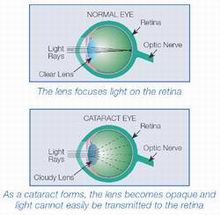What Is a Cataract?
A cataract is the normal age-related clouding of the eye's natural lens, which lies behind the iris and the pupil. The lens works much like a camera lens, focusing light onto the retina at the back of the eye. The lens also adjusts the eye's focus, letting us see things clearly both up close and far away.
The lens is a clear oval structure with three layers: the nucleus, the cortex, and the capsule. It may help to think of the lens structure as a peach, where the nucleus is the peach pit, the cortex is the flesh of the peach surrounding the pit, and the capsule is the peach skin, or elastic covering of the lens. The lens is supported inside the eye by tiny ligaments (zonules) that support the lens capsule.
In a young person, the lens is crystal clear and allows light to pass through and focus on the retina. As the lens ages, the nucleus turns yellow and hardens, thus losing its ability to change shape and focus for close work (termed “accommodation”). As the lens continues aging, the nucleus turns from yellow to amber and ultimately to brown. These changes cause clouding of the lens and blurred vision. Eventually, if we live long enough, we will all develop cataracts.
Common signs and symptoms:
For cataract sufferers, distance vision is blurry, especially when outdoors. Cataract sufferers feel more comfortable shading their eyes from the sun or wearing a visor, although sunglasses appear to reduce vision. Highway signs, particularly on bright days, can be difficult to read. Print is difficult to read in dim light. but in some cases reading vision may be improved.
Vision contrast and detail are also affected. The edges of stairs and curbs can be difficult to discern. Print appears faded and lacking in contrast and colours appear faded or changed in hue. For example, blue may appear as a shade of green, white as grey or beige, and yellow as white.
There may also seem to be streaks emanating from light sources, such as headlights and stop lights at night. The reflection of light from metal on a car, road pavement, or a bright, cloudy sky and fluorescent ceiling lights or bright reading lamps may also cause glare.
Risk factors:
While there are no known causes, studies have identified a number of risk factors:
• Cataracts are a normal part of aging. For people who fall between the following age groups:
o 52-64 years: 42% have cataracts
o 65-74 years: 73% have cataracts
o 74-84 years: 91% have cataracts
o 85 plus years: 95% have cataracts
• Excessive exposure to sunlight: Boaters, sunbathers, and people who do not habitually wear adequate protective eyewear are at risk.
• Cigarette smoking
• High cholesterol / triglycerides
• Diabetes Mellitus: Probably related to faulty glucose metabolism.
• Cortisone medication: Taken orally over a long period of time for medical conditions such as severe arthritis, lupus or related diseases.
• Eye injury
How is a cataract diagnosed?
An ophthalmologist, optometrist or family practitioner can diagnose the presence of a cataract through a routine eye examination. Once a cataract is detected, your ophthalmologist or optometrist will monitor its progression. The eye examination evaluates:
• the general health of your eye and the type of cataract;
• how your activities are affected by the cataract;
• whether your cataract should be removed by your ophthalmologist.
How can cataracts be treated?
Interestingly, modern cataract surgery is the most common operation in the Western world and is the safest prosthetic operation known to man. Modern cataract surgery does not employ laser surgery, is painless, and is often completed within an hour. Cataract surgery uses local anaesthetic and patients can opt to have a sedative, but it does not require a hospital stay. Patients return home the same day and can resume most daily activities the very next day.
No-stitch eye surgery such as phaco-emulsification painlessly removes the affected lens through a small, sutureless “keyhole” incision, and replaces it with a plastic lens implant. This new lens becomes a part of the eye, lasts the patient’s lifetime and requires no special care. The new clear lens implant is also able to improve the natural focus of the eye, allowing many patients to do without their prescription driving glasses after surgery.
Refractive-cataract surgery or the use of lens implants with vision correcting properties is another option for patients who require vision-correction. Various lens implants can help with short or long-sightedness and astigmatism. Close to 99% of patients are legally able to drive without glasses after surgery.
Can cataracts be prevented?
Currently, there is no proven way to prevent the development of cataracts other than controlling medical conditions that may be the cause. Antioxidants like beta carotene and vitamins C and E may reduce the risk of developing cataracts and slow its progression.
However, the prevalence of cataracts suggests that early diagnosis and treatment is key. If you think you suffer from cataracts, consult a qualified ophthalmologist or eye specialist for advice.









Join the Discussion
Type out your comment here:
You must be logged in to post a comment.